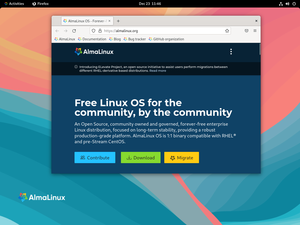
Back আলমালিনাক্স Bengali/Bangla AlmaLinux Czech AlmaLinux German AlmaLinux Spanish آلما لینوکس Persian AlmaLinux French AlmaLinux Hungarian AlmaLinux ID AlmaLinux Italian AlmaLinux Japanese
 Screenshot of default desktop on AlmaLinux version 9.1, showing AlmaLinux homepage in Firefox. | |||||
| Developer | The AlmaLinux OS Foundation | ||||
|---|---|---|---|---|---|
| Written in | C (kernel) | ||||
| OS family | Linux (Unix-like) | ||||
| Working state | Current | ||||
| Source model | Open source | ||||
| Initial release | 30 March 2021 | ||||
| Latest release |
| ||||
| Repository | github | ||||
| Marketing target | Servers, desktop computers, workstations, supercomputers | ||||
| Update method | DNF | ||||
| Package manager | RPM | ||||
| Platforms | x86-64 AArch64 ppc64le s390x | ||||
| Kernel type | Monolithic (Linux kernel) | ||||
| Userland | GNU | ||||
| Default user interface | GNOME Shell, Bash | ||||
| License | GPLv2 and others | ||||
| Preceded by | CentOS | ||||
| Official website | almalinux | ||||
AlmaLinux is a free and open source Linux distribution, developed by the AlmaLinux OS Foundation, a 501(c) organization, to provide a community-supported, production-grade enterprise operating system that is binary-compatible with Red Hat Enterprise Linux (RHEL). The name of the distribution comes from the word "alma", meaning "soul" in Spanish and other Latin languages. It was chosen to be a homage to the Linux community.[1]
The first stable release of AlmaLinux was published on March 30, 2021,[2] and will be supported until March 1, 2029.[3] AlmaLinux is built using publicly-viewable and reproducible methods using the AlmaLinux Build System (ALBS), which is a customized build system whose source code, like the distribution itself, is publicly distributed and licensed under open-source licenses.
- ^ "FAQ | AlmaLinux Wiki". wiki.almalinux.org. Retrieved 2021-06-20.
- ^ Vaughan-Nichols, Steven J. (March 30, 2021). "CloudLinux Launches AlmaLinux, CentOS Linux clone". ZDNet. Retrieved April 22, 2021.
- ^ "Release Notes | AlmaLinux Wiki". wiki.almalinux.org. Retrieved 2022-12-12.